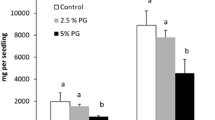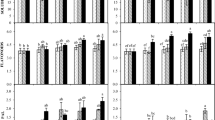Abstract
The effect of the herbicide chlorsulfuron on phenylpropanoid titer and metabolism and the role of endogenous ethylene in this response was examined in light-grown sunflower (Helianthus annuus L.) seedlings. Application of chlorsulfuron to the apex resulted in large increases in both total phenolic and hydroxycinnamic acid content in hypocotyls isolated from the treated seedlings. Both of these parameters were increased within 24 h of herbicide treatment, and both reached a maximum level 3–4 days post-treatment. An increase in ethylene evolution was found to proceed in parallel with the alterations of phenolic content. The extractable activities of phenylalanine ammonia lyase,trans-cinnamic-4-hydroxylase, and soluble peroxidase were increased by chlorsulfuron treatment. Chlorsulfuron had little effect on total phenolic content when administered directly to isolated hypocotyl segments. Exogenous ethylene had no effect on the endogenous titer of phenolic compounds. Root-fed cobalt chloride (5 × 10−4 M) inhibited chlorsulfuron-induced ethylene production by 92% and also inhibited the accumulation of phenolic materials by 56%. Exogenous ethylene was unable to reverse the inhibition caused by cobalt chloride. It was concluded that chlorsulfuron-induced increases in phenolic compounds were not mediated solely by endogenous ethylene.
Similar content being viewed by others
References
Abeles FB (1973) Ethylene in plant biology. Academic Press, New York
Amrhein N, Godekek Kefeli H (1976) The estimation of relative intracellular phenylalanine ammonia lyase (PAL)-activities, and modulationin vivo andin vitro by competitive inhibitors. Ber Dtsch Bot Ges 89:247–259
Camm EL, Towers GHN (1973) Phenylalanine ammonia lyase. Phytochemistry 12:961–973
Elstner EF, Konze JR (1976) Effect of point freezing on ethylene and ethane production by sugar beet leaf discs. Nature 263:351–352
Folin D, Ciocalteu V (1927) On tyrosine and tryptophane determinations in protein. J Biol Chem 73:627–650
Harborne JB (1982) Ecological biochemistry. Academic Press, New York
Hoagland RE, Duke SO (1981) Effects of herbicides on growth and extractable phenylalanine ammonia-lyase activity in light- and dark-grown soybean (Glycine max) seedlings. Weed Sci 29:433–439
Hyodo H, Kuroda H, Yang SF (1978) Induction of phenylalanine ammonia-lyase and increase in phenolics in lettuce leaves in relation to the development of Russet spotting caused by ethylene. Plant Physiol 62:31–35
Jangaard NO (1974) The effect of herbicides, plant growth regulators and other compounds on phenylalanine ammonia-lyase activity. Phytochemistry 13:1769–1775
Kefeli VI, Kadyrov CSh (1971) Natural growth inhibitors: Their chemical and physiological properties. Ann Rev Plant Physiol 22:185–193
Kende H, Hanson AD (1976) Relationship between ethylene evolution and senescence in morningglory flower tissue. Plant Physiol 57:523–527
Krygier K, Sosulski F, Hogge L (1982) Free, esterfied, and insoluble-bound phenolic acids: Extraction and purification procedure. J Agric Food Chem 30:330–334
Lamoureux GL, Rusness DG (1980)In vitro metabolism of pentachloronitrobenzene to pentachloromethylthiobenzene byonion is: Characterization of glutathione S-transferase, cysteine C-S lyase and S-adenosylmethionine methyl transferase activities. Pest Biochem Physiol 14:50–61
Levitt G, Ploeg HL, Weigel RC Jr, Fitzgerald DJ (1981) 2-Chloro-N-[(4-methoxy-6-methyl-1,3, 5-triazin-2-yl)aminocarbonyl] benzene-sulfonamide, a new herbicide. J Agric Food Chem 29: 416–418
Paradies I, Konze JR, Elstner EF, Paxton J (1980) Ethylene: Indicator but not inducer of phytoalexin synthesis in soybean. Plant Physiol 66:1106–1109
Rhodes MJC, Wooltorton LSC (1971) The effect of ethylene on the respiration and on the activity of phenylalanine ammonia lyase in swede and parsnip root tissue. Phytochemistry 10:1989–1997
Rhodes MJC, Wooltorton LSC (1973) Stimulation of phenolic acid and lignin biosynthesis in swede root tissue by ethylene. Phytochemistry 12:107–118
Rhodes JM, Wooltorton LSC (1978) The biosynthesis of phenolic compounds in wounded plant storage tissues. In: Kahl G (ed) Biochemistry of wounded plant tissues. deGruyter, Berlin, pp 243–286
Suttle JC (1982) Effect of chlorsulfuron on ethylene production. Plant Physiol 69:S-96
Suttle JC, Schreiner DR (1982) Effects of DPX-4189 (2-chloro-N-[(4-methoxy-6-methyl-1,3,5-triazin-2-yl)aminocarbonyl] benzene sulfonamide on anthocyanin synthesis, phenylalanine ammonia lyase activity and ethylene production in soybean hypocotyls. Can J Bot 60:741–745
Suttle JC, Swanson HR, Schreiner DR (1982) Effect of chlorsulfuron on phenylpropanoid metabolism in sunflower seedlings. Proc. Plant Growth Regul Soc, 9th Annual Meeting
Towers GHN, Wat C (1979) Phenylpropanoid metabolism. Planta Medica 37:97–114
Author information
Authors and Affiliations
Additional information
Mention of a trademark or proprietary product does not constitute a guarantee or warranty of the product by the U.S. Department of Agriculture and does not imply its approval to the exclusion of other products that may also be suitable.
Rights and permissions
About this article
Cite this article
Suttle, J.C., Swanson, H.R. & Schreiner, D.R. Effect of chlorsulfuron on phenylpropanoid metabolism in sunflower seedlings. J Plant Growth Regul 2, 137–149 (1983). https://doi.org/10.1007/BF02042242
Received:
Accepted:
Issue Date:
DOI: https://doi.org/10.1007/BF02042242




